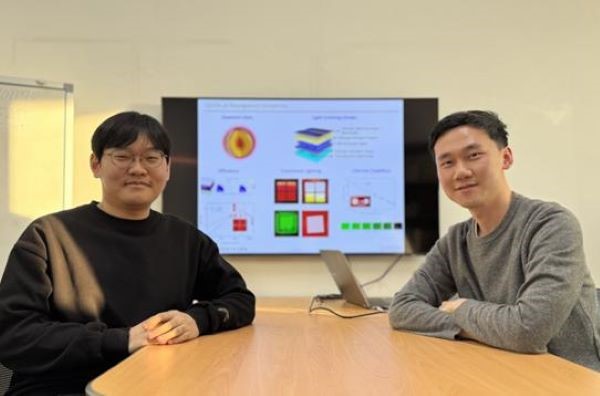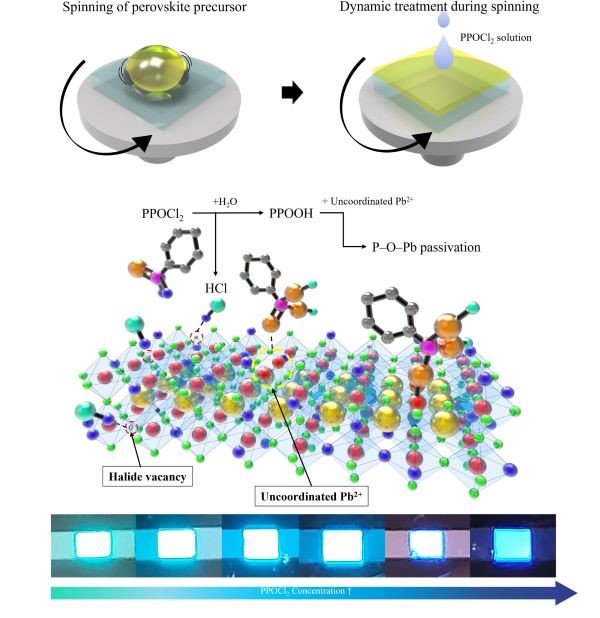Professor Lee Hyun-Ho and His Research Team Develop Deep-Blue Perovskite Light-Emitting Diodes
- admin
- 2025-01-10
- 1773
· Professor Lee Hyun-Ho (Department of Electronic Engineering) and His Research Team Develop Deep-Blue Perovskite Light-Emitting Diodes (LEDs)
45 views | Created
2024.12.24 | Modified 2024.12.24 | Public Relations Team
·
Professor Lee Hyun-Ho (Department
of Electronic Engineering) and His Research Team Develop Deep-Blue Perovskite
Light-Emitting Diodes (LEDs)
- Blue Shift in Emission
Wavelength and Improved Stability Through Perovskite Surface Treatment -
- Published a paper in
the internationally renowned journal Applied Surface Science, published by
Elsevier (IF: 6.3) -
Professor Lee Hyun-Ho (Department of Electronic
Engineering) and his research team at Kwangwoon University proposed a
dynamic-treatment method using phenylphosphonic dichloride (PPOCl2) to
achieve defect passivation and a blue shift in the emission wavelength of
perovskite emissive layers. Their study reported a deep-blue perovskite
light-emitting diode (LED) that meets the Rec.2020 video broadcasting standard
established by the International Telecommunication Union (ITU).

(Left) Yoon Beom-Hee, Integrated Master's and
Ph.D. Program Researcher; (Right) Lee Hyun-Ho, Professor
Perovskite light-emitting
diodes, known as next-generation display devices, are being researched for
their high color purity and low processing costs. However, improving the
performance of blue perovskite light-emitting diodes is essential for their
successful commercialization.
Numerous studies have introduced
treatment methods to achieve a blue shift in the emission wavelength of
perovskite light-emitting diodes, aiming to meet the deep-blue wavelength (467
nm) specified by Rec.2020, the video broadcasting standard set by the
International Telecommunication Union (ITU). However, reports on deep-blue
perovskite light-emitting diodes achieving an emission wavelength of 467 nm or
lower remain limited. Therefore, understanding the structural mechanisms and
achieving a blue shift in the emission wavelength are essential for developing
deep-blue perovskites.
This study utilized a dynamic-treatment method
with PPOCl2 to induce defect passivation and a blue shift in the
emission wavelength of perovskite emissive layers. As a result, the phosphonate
group (P=O) in PPOCl2 formed P-O-Pb bonds with Pb2
defects in the perovskite, effectively passivating the defects and improving
the device's performance and operational stability. Simultaneously, the HCl
byproduct filled halide vacancies within the perovskite, increasing the Cl
content, which led to a blue shift in the emission wavelength. The resulting
perovskite light-emitting diode exhibited a deep-blue emission wavelength of
467 nm, meeting the requirements of the Rec.2020 standard.
The research team hopes that the spectral shift
mechanism achieved through the dynamic-treatment method using PPOCl2
will be applied not only to perovskite light-emitting diodes but also to
various other fields involving blue light-emitting diodes.

Meanwhile, this research was conducted with
support from the University Research Institute Program (2018R1A6A1A03025242,
2022R1F1A1066526) and Kwangwoon University. The findings were published in
Applied Surface Science (IF: 6.3), an internationally renowned journal by
Elsevier.
https://doi.org/10.1016/j.apsusc.2024.161623
https://www.kw.ac.kr/ko/life/research.jsp?BoardMode=view&DUID=48796?